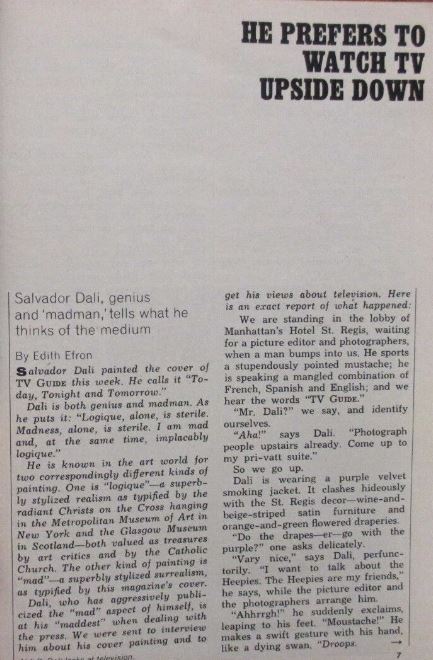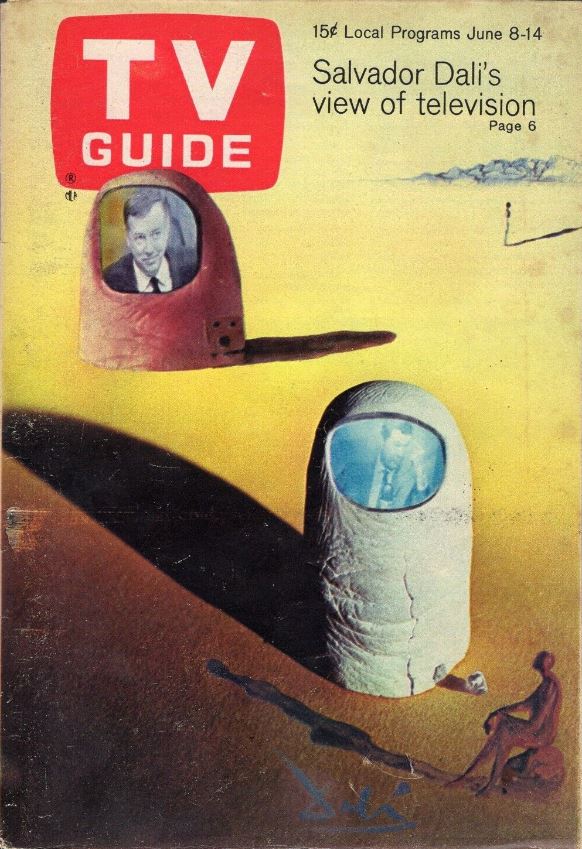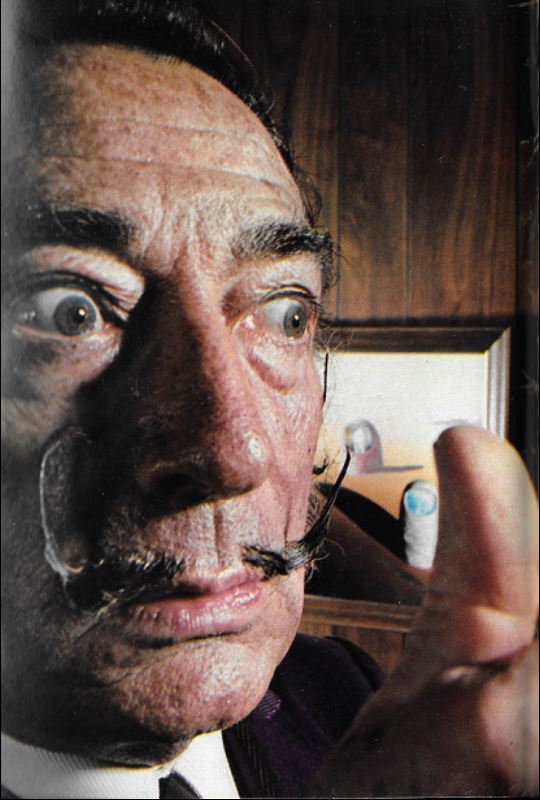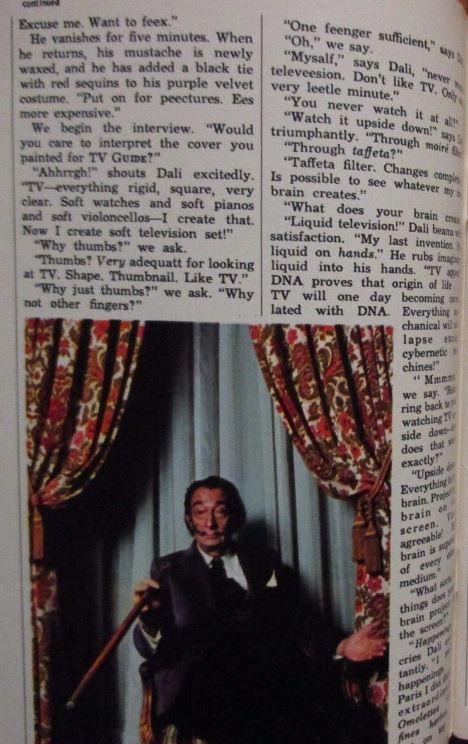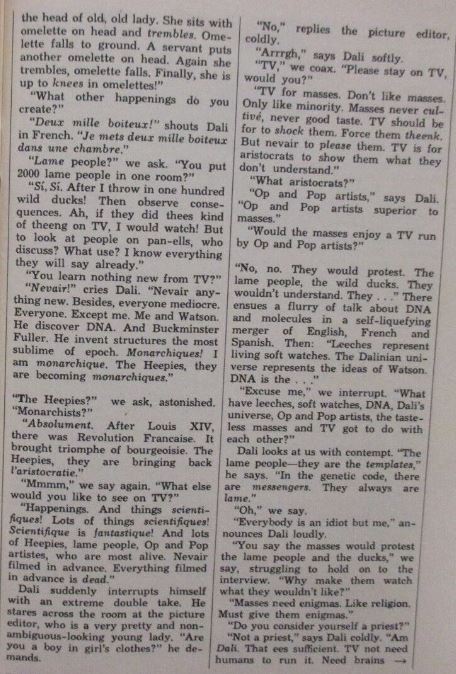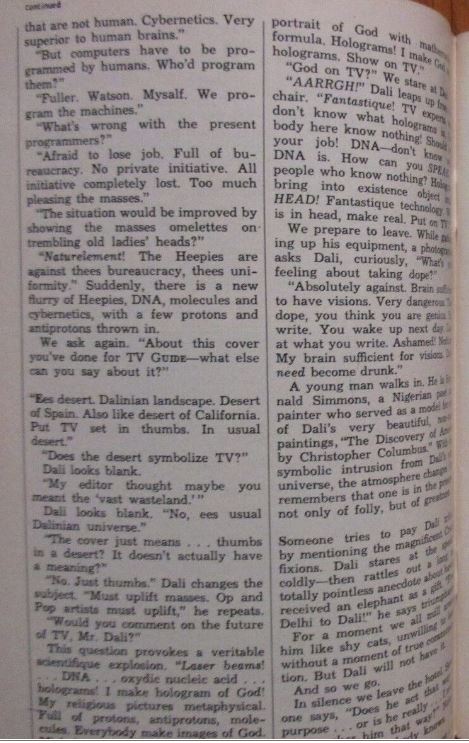McLuhan to Sheila Watson, June 12, 1968:1
Obtain cover of TV Guide for June 8-14. It is a Dali explanation of the tactile nature of the TV image. Wonderful interview inside, too.
Here is that wonderful interview…2
He Prefers To Watch TV Upside Down
Salvador Dali, genius
and madman, tells what he
thinks of the medium
By Edith Efron
Salvador Dali painted the cover of TV Guide this week. He calls it ‘Today, Tonight and Tomorrow’.3
Dali is both genius and madman. (…)
We were sent to interview him about his cover painting and to get his views about television. Here is an exact report of what happened. (…)
“I want to talk about the Heepies. The Heepies are my friends”, he says, while the picture editor and the photographers arrange him. (…)
We begin the interview. “Would you care to interpret the cover you painted for TV Guide?”
“Ahhrrgh,” shouts Dali excitedly. “TV — everything rigid, square, very clear. Soft watches, soft pianos, soft violoncellos — I create that. Now I create soft television.”
“Why thumbs?”, we ask.
“Thumbs? Very adequatt for looking TV. Shape. Thumbnail. Like TV.”
“Why just thumbs?” We ask. Why not other fingers?
“One feenger sufficient”, says Dali.
“Oh”, we say.
“Myself”, says Dali, “never watch television. Don’t like TV. Only one very leetle minute.”
“You never watch it at all?”
“Watch it upside down”, says Dali triumphally. “Through moiré filter.”
“Through taffeta?”
“Taffeta filter. Change completely. Is possible to see what my own brain create.”
“What does your brain create?”
“Liquid television!” Dali beams with satisfaction. “My last invention. Put liquid on hands.” He rubs imaginary liquid into his hands. “TV appear! DNA proves that origin of life . . . TV one day become correlated with DNA. Everything mechanical collapse except cybernetic machines!”
“Mmmmm”, we say. “Referencing back to your watching TV upside down — how does that work exactly?”
“Upside down. Everything in my brain. Project my brain on the screen. Vary agreeable! My brain very superior every medium.”
“What sort of thing does your brain project on the screen?”
“Happenings!” cries Dali instantly. “I make happenings in Paris. I did things extraordinaire. Omelettes aux fines herbes put on head of old, old lady. She sits with omelette on head, trembles. Omelette falls to ground. Servant puts other omelette on head. Again she tremble, omelette falls. Finally, she up to knees in omelettes!”
“What other happenings do you create?”
“Deux mille boiteux!” shouts Dali in French. “Je mets deux mille boiteux dans une chambre.”
“Lame people?” we ask. “You put 2000 lame people in one room?”
“Si, si. After I throw one hundred wild ducks! Then observe. Ah, if they did thees kind of theeng on TV, I would watch! But to look at people on pan-ells who discuss? What use? I know everything they say already.”
“You learn nothing new from TV?”
”Nevair”, cries Dali. ”Nevair anything new. Besides, everyone mediocre. Everyone. Except me. Me and Watson. Discover DNA. And Buckminster Fuller. Invent structures the most sublime of epoch. Monarchiques! I’m monarchique. The Heepies, they are becoming monarchiques.”
”Excuse me”, we interrupt. “The Heepies?” we ask, astonished.
“Absolument. After Louis XIV there was Revolution Française. It brought triomphe of bourgeoisie. The Heepies, they bringing back l’aristocratie.”
“Mmmm,” We say again. “What else would you like to see on TV?”
“Happenings. And things scientifiques! Lots of things scientifiques! And lots of Heepies, lame people. 0p and Pop artists who are most alive. Nevair filmed in advance. Everything filmed advance dead.”
Dali suddenly interrupts himself with an extreme double take. He stares across the room at the picture editor, who is a very pretty and non-ambiguous-looking young lady. “Are you boy in girl’s clothes?” he demands.
“No”, replies the picture editor coldly.
“Arrrgh,” says Dali softly.
“TV”, we coax. “Please stay on TV, would you?”
“TV for masses. Don’t like masses. Only like minority. Masses never cultivé, never good taste. TV should be for to shock them. Force them theenk. But nevair to please. TV for aristocrats to show them [the masses] what they don’t understand.”
”What aristocrats?”
”Op and Pop artists”, says Dali. ”Op and Pop artists superior to masses.”
“Would the masses enjoy a TV run by Op and Pop artists?”
“No, no. They would protest. The lame people, the wild ducks. They wouldn’t understand. They…” There ensues a flurry of talk about DNA and molecules in a self-liquefying merger of English, French and Spanish. Then: “Leeches represent living soft watches. The Dalínian universe represents the ideas of Watson. DNA is the… ”
“Excuse me,” we interrupt . ”What have leeches, soft watches, DNA, Dali’s universe, Op and Pop artists, the taste-less masses and TV got to do with each other?”
Dali looks at us with contempt . “The lame people – they are the templates,” he says. “In the genetic code, there are messengers. They always lame.”
”Oh,” we say.
“Everybody idiot but me,” announces Dali loudly.
”You say the masses would protest the lame people and the ducks,” we say, struggling to hold on to the interview. “Why make them watch what they wouldn’t like?”
”Masses need enigmas. Like religion. Must give them enigmas”.
“Do you consider yourself a priest?”
”Not a priest”, says Dali coldly. “Am Dali. That ees sufficient. TV not need humans to run it. Need brains not human. Cybernetics. Very superior to human brains.
“But computers have to be programmed by humans. Who’d program them?”
“Fuller. Watson. Myself. We program the machines.”
“What’s wrong with the present programmers?”
“Afraid to lose job. Full of bureaucracy. No private initiative. All initiative completely lost. Too much pleasing the masses.”
“The situation would be improved by showing the masses omelletes on trembling old ladies’ heads?”
“Naturalement! The Heepies are against thees bureaucracy, thees uniformity.” Suddenly, there is a new flurry of Heepies, DNA, molecules and cybernetics, with a few protons and antiprotons thrown in.
We ask again. “About this cover you’ve done for TV Guide — what else can you say about it?”
“Ees desert. Dalínian landscape. Desert of Spain. Also like desert of California. Put TV set in thumbs. In usual desert.”
Does the desert symbolize TV?”
Dali looks blank.
“My editor thought maybe you meant the ‘vast wasteland’.”
Dali looks blank. “No, ees usual Dalían universe.”
“The cover just means…thumbs in a desert? It doesn’t actually have a meaning?”
“No. Just thumbs.” Dali changes the subject. “Must uplift masses. Op and Pop artists must uplift”, he repeats.
“Would you comment on the future of TV, Mr. Dali?”
This question provokes a veritable scientifique explosion. “Laser beams…DNA…oxydic nucleic acid…holograms! I make hologram of God!..My religious pictures metaphysical. Full of protons, antiprotons, molecules. Everybody make images of God. Michelangelo make of marble. Who make God like that? I make portrait of God with mathematical formula. Holograms! I make God with holograms. Show on TV. Fantastique!
“God on TV?” We stare at Dali.
“Ahhrrgh”, Dali leaps up from his chair. “Fantastique. TV experts don’t know what hologram is. Nobody here know nothing. Should do your job! DNA — don’t know what DNA is. How can you SPEAK people who know nothing? Hologram bring Into existence object in HEAD. Fantastique technology. God is in head, make real. Put on TV”. (…)
Someone tries to pay Dali tribute by mentioning his magnificent Crucifixion [paintings]. Dali stares at the speaker — and then rattles off a long and totally pointless anecdote about having received an elephant as a gift. “From Delhi to Dali”, he says triumphantly.
For a moment we all mill around him like stray cats, unwilling to go without a moment of true communication. But Dali will not have it.
- Letters, p353. ↩
- Interview with Salvador Dali by Edith Efron, TV Guide, June 8-14, 1968, pp6-10. The transcript here has been prepared from online photographs of this TV Guide interview. Copies of the issue are regularly offered at ebay and elsewhere and sellers often illustrate their wares in this way. The interview has been lightly edited by omitting some of the less interesting material and by deleting words Dali probably did not use. For example, Ephron’s “Is possible to see whatever my own brain create” appears as “Is possible to see what my own brain create”. Dali might have known the word ‘whatever’; but he was too much of a genius to use it in the way reported by Efron in an interview with the press. Still, odd constructions like “No private initiative” remain. Could Dali really have said this? Or, at least, could he really have made his point about the lack of creativity in TV in such strange (for him) language as this? ↩
- The ‘Today Show’ and the ‘Tonight Show’ were TV programs in 1968 — which are still going 55 years later in 2023. The ‘Tomorrow Show’ would also become a TV program, but only 5 years later in 1973. Its use in the title of the TV Guide cover painting has the effect of contrasting present time, ‘Today’ and ‘Tonight’, with the future, ‘Tomorrow’. Or, as Dali’s intent seems to have been, to use time to contrast unreality with reality and superficiality with creative work. ↩
